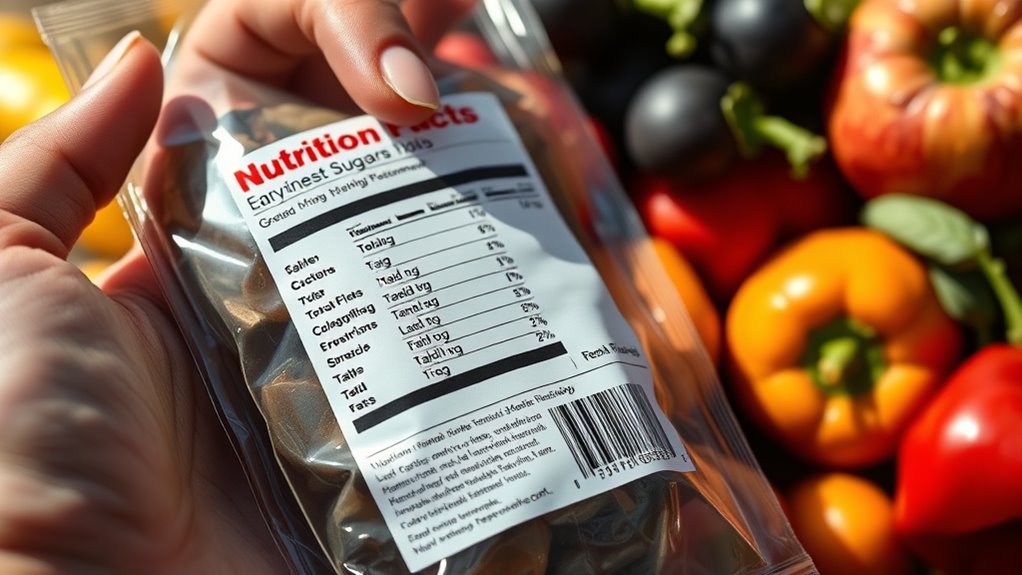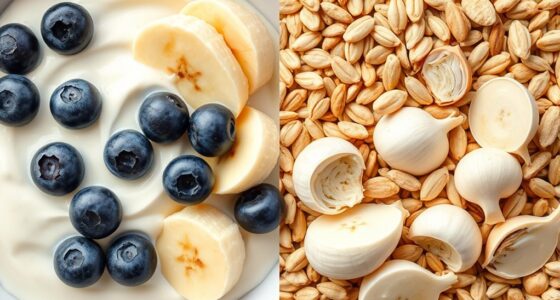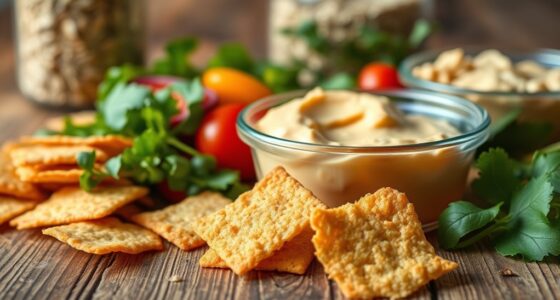To spot hidden sugars in food labels, start by checking the ingredients list for sneaky names like high-fructose corn syrup, dextrose, or syrup. Focus on the “Total Sugars” and “Added Sugars” lines on the Nutrition Facts panel, and compare products to choose ones with less sugar overall. Pay attention to serving sizes too. Keep in mind, understanding these labels helps you make smarter choices—if you keep exploring, you’ll uncover even more tips.
Key Takeaways
- Carefully read both the nutrition facts and ingredient list, focusing on “Total Sugars” and “Added Sugars.”
- Look for sneaky sugar names like syrup, juice concentrate, or ingredients ending in “-ose.”
- Compare serving sizes and grams of sugar across products to identify lower-sugar options.
- Check for “Includes Xg Added Sugars” to understand hidden or extra sweeteners.
- Choose minimally processed foods with fewer ingredients to reduce hidden sugar intake.
Understanding the Nutrition Facts Label

While the Nutrition Facts label might seem straightforward, understanding it is essential for identifying hidden sugars in your food. The label provides crucial information about serving size, calories, and nutrient content. Focus on the “Total Carbohydrates” section, which includes sugars, fiber, and starches. The amount of added sugars is often listed separately under “Includes Xg Added Sugars,” making it easier to spot sweeteners that aren’t natural. Pay attention to serving sizes, as larger servings can mask high sugar content. Reading labels carefully helps you compare products and choose options with lower sugar levels. Remember, just because a product says “sugar-free” or “healthy,” doesn’t mean it’s free of added sugars. Mastering how to read these labels puts you in control of your dietary choices. Additionally, being aware of ingredients such as added sugars can help you avoid products with hidden sweeteners that may not be obvious from the nutrition label alone.
Recognizing Different Names for Sugars
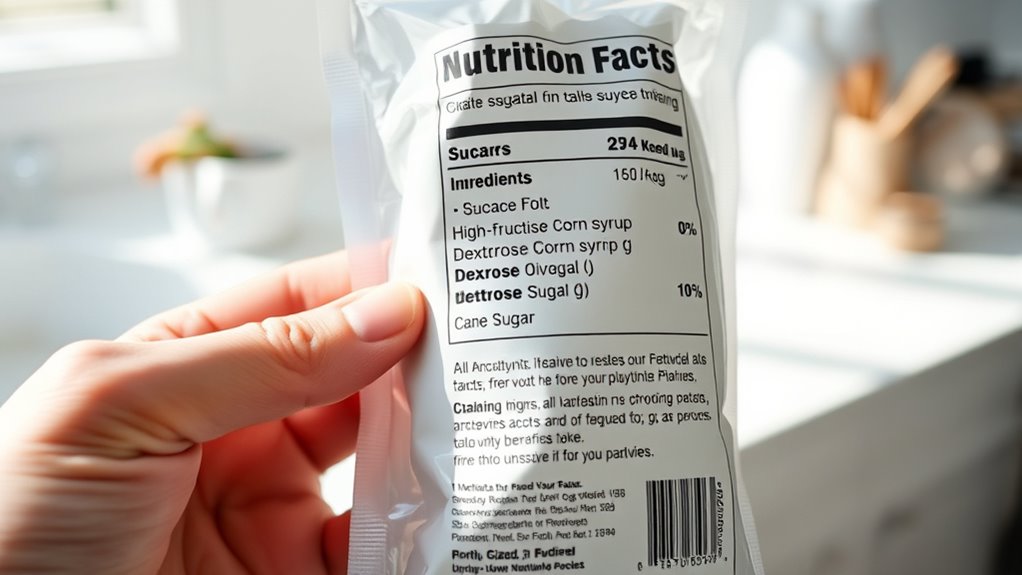
Since manufacturers often use various names for sugars on ingredient labels, learning to recognize these terms is essential for identifying hidden sweeteners in your food. Sugar can hide under many names, making it tricky to spot. Look for words ending in “-ose,” like glucose, fructose, dextrose, and maltose. Other common names include cane sugar, corn syrup, high-fructose corn syrup, honey, agave nectar, rice syrup, and evaporated cane juice. Even less obvious terms like syrup, juice concentrate, or fruit nectar can contain added sugars. By familiarizing yourself with these different names, you can better assess whether a product contains hidden sugars. Being vigilant helps you make healthier choices and avoid consuming more added sugar than you realize. Recognizing common sugar sources on labels is a key step toward healthier eating habits.
Checking the Total Sugar and Added Sugar Lines

When you check food labels, pay attention to the total sugar and added sugar lines. Knowing the difference helps you identify products with unnecessary or excessive sugars. This awareness empowers you to make healthier choices and reduce hidden sugar intake. Being aware of regulatory compliance can also help you understand labeling accuracy and avoid misleading claims.
Total Sugar Awareness
Understanding the difference between total sugar and added sugar on nutrition labels is essential for making healthier choices. Total sugar includes all sugars present, whether naturally occurring or added, while added sugar refers specifically to sugars added during processing. Recognizing this helps you assess a product’s overall sweetness and nutritional value. Being aware of sugar sources can help you better evaluate your diet and prevent excess consumption.
Here’s a quick guide:
| Sugar Type | What It Includes | Why It Matters |
|---|---|---|
| Total Sugar | Naturally occurring + added sugars | Overall sugar content |
| Added Sugar | Sugars added during processing | Hidden sources of sugar |
| Natural Sugar | Fruits, dairy, and whole foods | Usually healthier options |
| Limit | Keep added sugars low | Prevent health risks |
| Check Labels | Always compare total and added | Make smarter choices |
Be vigilant to keep your sugar intake in check.
Identifying Added Sugars
Ever wonder how to spot added sugars on a nutrition label? Checking the “Total Sugars” and “Added Sugars” lines helps you identify hidden sweeteners. First, look for the “Added Sugars” line, which reveals sugars added during processing. If only total sugars are listed, check the ingredients for clues like syrup, glucose, or high-fructose corn syrup. Keep in mind, some labels combine natural and added sugars under “Total Sugars,” so reading ingredients is essential. Here are key tips:
- Focus on “Added Sugars” line for clear info
- Compare total sugars with ingredients for hidden sources
- Beware of confusing terms like “evaporated cane juice”
- Look for syrups, concentrates, and sweeteners in ingredients
- Remember, less added sugar means a healthier choice
- Understanding vacuums for pet hair can help you maintain a cleaner home free of allergens and hair buildup
Spotting Hidden Sugars in Ingredients Lists
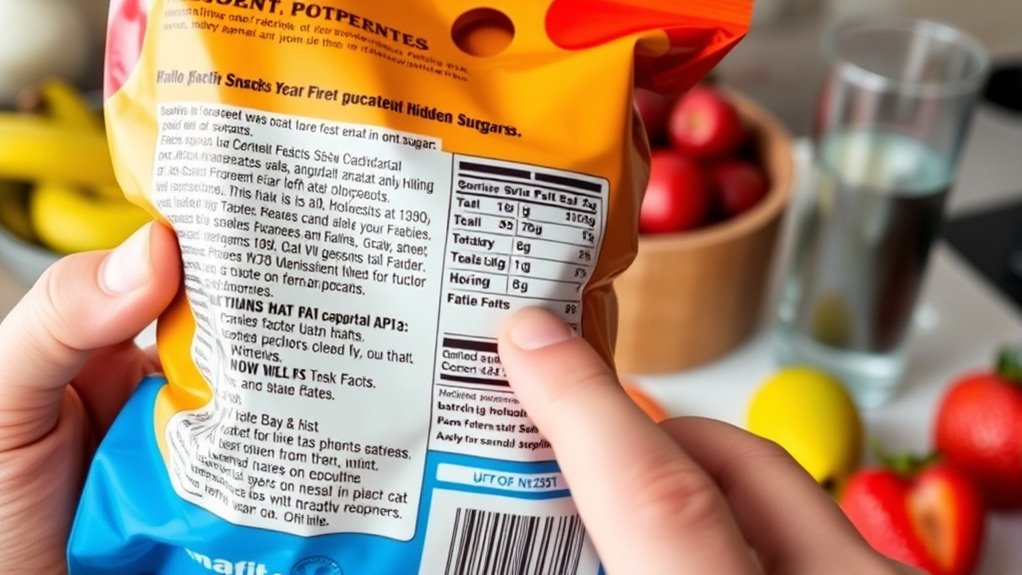
When reading ingredients lists, look out for common sugar names like sucrose, glucose, and high fructose corn syrup. These hidden additives can disguise added sugars you might not expect. Learning to recognize these names helps you spot and avoid unnecessary sugar intake. Additionally, being aware of support networks for new fathers can empower you to manage stress and make healthier choices for your family.
Common Sugar Names
Have you ever looked at an ingredient list and wondered where all the added sugars are hiding? Many names mask sugar’s presence, making it hard to spot. Knowing common sugar names helps you identify hidden sugars quickly. Here are some you should watch for:
- High fructose corn syrup
- Cane sugar
- Glucose
- Fructose
- Evaporated cane juice
Other less obvious names include honey, agave nectar, and fruit juice concentrates. These can appear in unexpected products, like flavored yogurt or bread. By recognizing these terms, you can better control your sugar intake. Remember, manufacturers often use different names to disguise added sugars, so staying familiar with these terms is key to making healthier choices.
Uncovering Hidden Additives
To uncover hidden sugars, you’ll need to carefully read ingredient lists and recognize less obvious additives that indicate added sweetness. Look beyond sugar and honey; many products hide sweeteners under names like corn syrup, high-fructose corn syrup, dextrose, maltose, or glucose. Some ingredients, such as evaporated cane juice, fruit nectar, or rice syrup, also signal added sugars. Be cautious of words ending in “-ose,” which often denote sugars. Artificial sweeteners like aspartame or sucralose may appear, but they don’t add sugar directly. By familiarizing yourself with these less obvious terms, you can better identify hidden sugars lurking in processed foods, helping you make healthier choices and reduce your overall sugar intake. Additionally, monitoring color accuracy in food products can sometimes indicate the presence of artificial coloring or additives used to enhance visual appeal, which may also be associated with processed ingredients.
Comparing Products to Make Smarter Choices
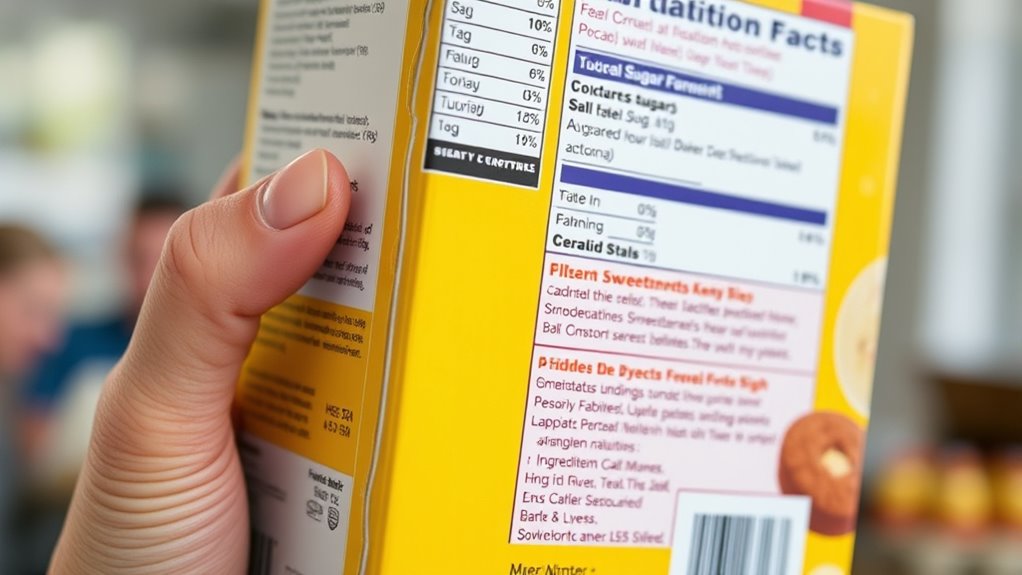
Ever wonder how to spot hidden sugars when comparing food labels? It’s easier than you think. First, check the ingredient list for sneaky names like high-fructose corn syrup, dextrose, or sucrose. Next, compare the total sugar grams across products—lower is better. Pay attention to serving sizes, as larger servings can hide more sugar. Look for products with minimal added sugars rather than those that rely on natural sweetness. Finally, consider the overall nutrient profile—aim for options with more fiber and protein, which help balance blood sugar levels. Being aware of sugar content in processed foods can help you make healthier choices.
- Read ingredients carefully, not just the nutrition facts
- Watch for alternative sugar names
- Compare serving sizes accurately
- Prioritize products with less added sugar
- Focus on whole, minimally processed foods
Tips for Avoiding Unintended Sugar Consumption

Since added sugars can sneak into foods you wouldn’t expect, it’s important to stay vigilant when shopping or eating out. Always read nutrition labels carefully, focusing on the total grams of sugar per serving. Look beyond the word “sugar” and check for other names like high-fructose corn syrup, cane syrup, or agave nectar. Choose whole, unprocessed foods whenever possible, such as fresh fruits, vegetables, and nuts, which naturally contain less added sugar. When dining out, ask about ingredients and opt for dishes that aren’t heavily sauced or glazed. Be cautious of “low-fat” or “light” products; they often compensate with added sugars. Understanding the types of added sugars included in your foods can help you make smarter choices. By staying aware and making informed choices, you can considerably reduce your unintended sugar intake.
Frequently Asked Questions
How Can I Identify Hidden Sugars in Processed Foods Not Listed on Labels?
You can identify hidden sugars in processed foods by checking ingredient lists carefully. Look for words ending in “-ose” like glucose, fructose, or sucrose, as well as syrups, malt, honey, and juice concentrates. Even if sugar isn’t listed as a main ingredient, these hidden sources might be present. Staying vigilant and reading labels thoroughly helps you avoid unexpected sugar intake and make healthier choices.
Are Natural Sugars Like Honey or Agave Considered Harmful When Reading Labels?
Did you know that natural sugars like honey and agave can be as high in calories as processed sugars? When reading labels, don’t assume they’re harmless—these natural sweeteners can still spike your blood sugar. While they may offer some nutrients, consuming them in excess isn’t ideal. Always check the ingredient list; if you see honey or agave listed, remember moderation is key to maintaining a balanced diet.
Do Sugar Alcohols and Artificial Sweeteners Impact Blood Sugar Levels?
Sugar alcohols and artificial sweeteners can impact your blood sugar levels differently. Some sugar alcohols, like sorbitol, may cause a slight spike, while others, such as erythritol, usually don’t affect blood sugar much. Artificial sweeteners like aspartame or sucralose generally don’t raise blood sugar, but individual responses vary. It’s best to monitor how your body reacts and consult your healthcare provider for personalized advice on including these in your diet.
How Reliable Are “Sugar-Free” Claims on Food Packaging?
Sure, “sugar-free” sounds like a sweet deal, but don’t let the label fool you. Manufacturers can slap that claim on products with minimal oversight, and hidden sugars or sugar alcohols might still spike your blood sugar. You’re better off scrutinizing ingredient lists and carbs than trusting a catchy phrase. That label’s just a shiny disguise—stay vigilant, and know what you’re really eating.
Can Cooking or Homemade Recipes Contain Hidden Sugars Not Listed?
You might not realize that cooking or homemade recipes can contain hidden sugars, even if you don’t add sugar explicitly. Ingredients like sauces, condiments, and processed foods often have added sugars that aren’t obvious. When you prepare meals, check labels on store-bought items and be aware that natural ingredients like fruit or dairy can also contribute sugars. Staying vigilant helps you control your sugar intake better.
Conclusion
By learning to read food labels carefully, you can spot hidden sugars and make healthier choices. Did you know that the average American consumes about 17 teaspoons of added sugars daily? That’s far above the recommended limit! Staying vigilant helps you avoid unnecessary sugar intake, which can impact your overall health. So, keep checking those labels, recognize sneaky sugar names, and take control of your diet for a healthier, happier life.
